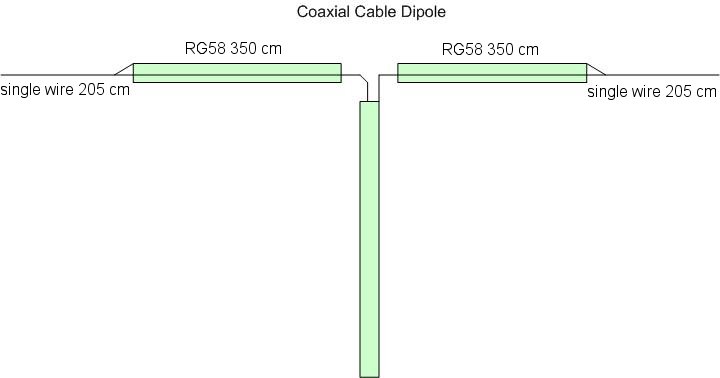Coaxial Cable Dipole for 10MHz
October 2006
When I decided to start transmitting on 10MHz I had to face the "antenna dilemma". I did not want to buy a ready made antenna, I wanted to homebrew it. Thus I had to cope with the size of my house's roof. A vertical was out of question, due to the lack of suitable supports. An inverted V dipole was the only antenna I could install...But the roof is too small for a full size dipole, even in an inverted V configuration. I decided to use RG58 coaxial cable to take advantage of the velocity factor of the cable. Thus the length of each arm of the dipole was reduced to 4,88 metres instead of 7,39 metres. Because I had two pieces of cable of just 3.50 metres I decided to set up a dipole and test it in the garden. As expected it was too short and resonated somewhere around 14MHz. I than started adding pieces of ordinary electric wire to the coax moving the resonant frequency downward up to 10MHz..."et voila" the antenna was ready! The final tuning was done with the antenna on the roof.
Fig. 1 is a sketch of the antenna: the coaxial cable to the rig is connected to the inner conductor of the coax of the dipole and these pieces are shortened (braid twisted to the inner conductor) at their end where the single wire is soldered.

Fig. 1 sketch of the antenna
A few pictures of the antenna (click on the image to enlarge)
In the background the 5/8 for 28 MHz (ex 27 MHZ)
Fig. 2 is the screenshot of my miniVNA showing the resonant frequency (green vertical dashed line) and the 1:2 SWR bandwidth (M1 and M2 markers).

Fig. 2 miniVNA screenshot
Fig. 3 shows a very interesting characteristic of this particular design: the fact that the antenna has 3 resonant frequencies! 10MHz, 16MHz and 36MHz. And that these 3 frequencies are not harmonically related. They depend on the length of the segments the antenna is made with. 10MHz is the total length of the antenna (coax+single wire), 36MHz is the single wire portion. Up to now I cannot figure where the 16MHz comes from!

Fig. 3 the 3 resonant frequencies
Although this antenna works quite well I don't think it is worth to be copied as I built it with cables I found in the junk box! For the next one I build I will properly cut the coax to resonate the antenna without the use of "tails"...